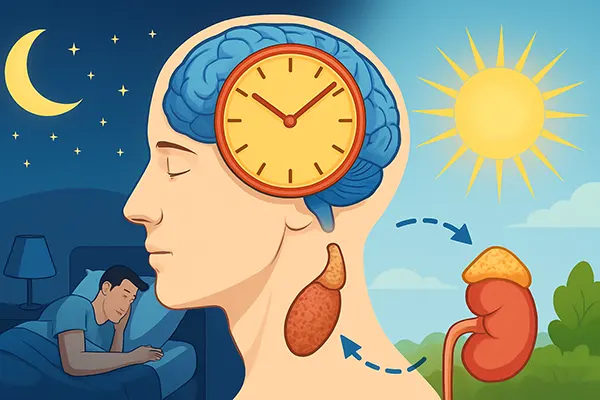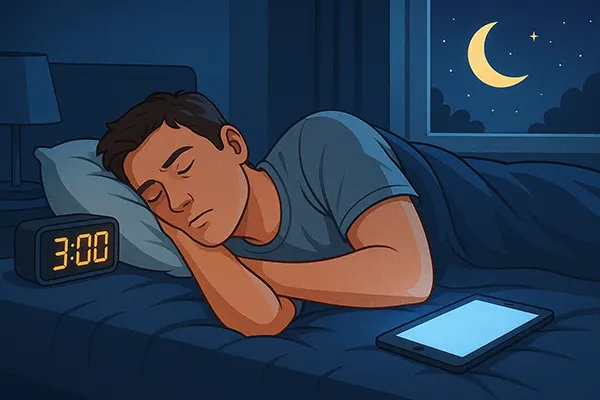
Circadian Rhythms: Why Disrupting the Biological Clock Harms Your Health
The human body is governed by a biological timing system known as the circadian rhythm. This internal clock influences nearly every physiological process, including sleep, hormone release, metabolism, and immune response. Disruption to this system, whether through lifestyle, shift work, or travel, can lead to significant health consequences. As scientific understanding of circadian biology deepens, it’s increasingly clear that maintaining synchrony with this natural cycle is essential to long-term well-being.
The Science Behind Circadian Rhythms
Circadian rhythms are 24-hour cycles that operate in sync with the Earth’s rotation. They are regulated by the suprachiasmatic nucleus (SCN) in the hypothalamus, which responds primarily to light cues. This master clock coordinates peripheral clocks in various organs, ensuring that bodily functions occur at optimal times.
Melatonin, a hormone released in darkness, plays a key role in initiating sleep and regulating the sleep-wake cycle. Conversely, cortisol levels peak in the early morning to promote alertness. These hormonal rhythms are tightly controlled by circadian signalling.
Disturbances to light exposure—especially blue light at night—can shift the timing of the circadian clock. This misalignment affects not only sleep quality but also metabolic and cardiovascular health, setting the stage for chronic conditions.
Health Impacts of Circadian Misalignment
Persistent circadian disruption has been linked to an increased risk of various diseases. These include obesity, type 2 diabetes, cardiovascular disorders, and even certain cancers. The World Health Organization now classifies night shift work as a probable carcinogen due to its impact on melatonin suppression and clock gene expression.
Mood and cognitive performance are also highly sensitive to circadian timing. Individuals with misaligned schedules often report irritability, concentration problems, and depressive symptoms. These effects are especially pronounced in teenagers and older adults, whose natural rhythms tend to drift later or become weaker, respectively.
Furthermore, immune function is time-dependent. Disrupted sleep patterns can alter the production of cytokines and impair the body’s ability to respond to infections. In the long term, this may contribute to systemic inflammation and autoimmune conditions.
Modern Lifestyle and Circadian Disruption
In the digital age, exposure to artificial light, irregular meal times, and screen-based entertainment have become major disruptors of the biological clock. The constant availability of stimuli delays bedtime and shortens sleep duration, particularly among adolescents and young adults.
Shift workers represent a high-risk group. Their inverted schedules force the body into a continual state of desynchronisation. Studies have shown that people working night shifts have higher incidences of metabolic syndrome, cardiovascular disease, and gastrointestinal disorders.
Moreover, jet lag from long-haul flights can lead to short-term circadian misalignment. While temporary, repeated travel across time zones without proper recovery may have cumulative effects on health, particularly among frequent flyers such as business travellers and athletes.
Chronobiology and Nutritional Timing
Meal timing is a crucial component of circadian health. Eating late at night can lead to impaired glucose tolerance, weight gain, and elevated triglyceride levels. The circadian system influences insulin sensitivity and digestive efficiency, which peak during daylight hours.
Time-restricted eating (TRE), which aligns food intake with daylight periods, has shown promise in improving metabolic markers such as blood pressure, cholesterol, and inflammatory cytokines. These benefits occur even without reducing total caloric intake.
Research indicates that synchronising food consumption with the internal clock may aid in weight management and reduce the risk of metabolic diseases. This has led to growing interest in circadian-aligned dietary interventions, especially in preventive health strategies.

Strategies for Supporting Circadian Health
Protecting the body’s internal clock requires intentional daily habits. Regular exposure to natural morning light helps reinforce the correct timing of sleep and wake cycles. Equally important is minimising artificial light—particularly blue light—after sunset.
Consistency in sleep and wake times, even on weekends, strengthens the circadian rhythm. Disruptions like “social jet lag” (sleeping in on days off) can lead to misalignment similar to actual travel jet lag, impairing recovery and performance.
Exercise timing also plays a role. Morning or early afternoon workouts are generally more supportive of circadian function, while late-night physical activity may delay melatonin production. Aligning physical activity with daylight hours promotes hormonal balance and restorative sleep.
Technological and Behavioural Interventions
Blue-light blocking glasses, dimmable warm lighting, and screen filters are increasingly used to reduce circadian disruption from electronic devices. Smart lighting systems that mimic natural light progression can assist shift workers and night owls in adjusting their rhythms.
Behavioural therapy, such as Cognitive Behavioural Therapy for Insomnia (CBT-I), has been effective in managing sleep disorders related to circadian misalignment. These interventions focus on building healthy sleep habits, exposure to light, and managing anxiety around sleep.
Wearable technology, including sleep trackers and light therapy devices, offers personalised insights into circadian patterns. When used consistently, they can guide behavioural adjustments that promote long-term circadian alignment and improved health outcomes.
